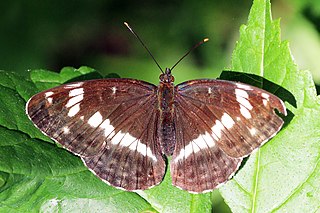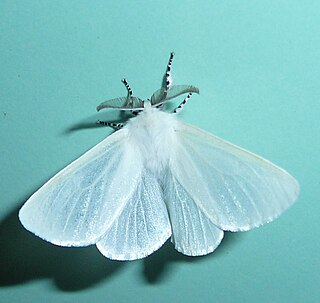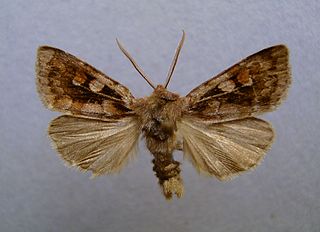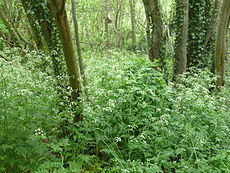
Limenitis camilla, the (Eurasian) white admiral, is a butterfly of the family Nymphalidae. It is found in woodland throughout southern Britain and much of Europe and the Palearctic, extending as far east as Japan.

Lygephila pastinum, the blackneck, is a moth of the family Erebidae. The species was first described by Georg Friedrich Treitschke in 1826. It is found in Europe and across the Palearctic Siberia, the Russian Far East, Japan and China.

Spilosoma lubricipeda, the white ermine, is a moth of the family Erebidae. It is found throughout the temperate belt of Eurasia from Europe through Kazakhstan and southern Siberia to Amur Region, China, Korea and Japan. In China several sibling species occur.

Setina irrorella, the dew moth, is a moth of the family Erebidae. The species was first described by Carl Linnaeus in his 1758 10th edition of Systema Naturae. It is found in the Palearctic from Ireland, then through Europe and east to northern and central Asia to the Pacific Ocean. It is missing in the high north and parts of the Mediterranean region. It is found also in the limestone Alps up to 2,000 meters above sea level.

Nudaria mundana, the muslin footman, is a moth of the subfamily Arctiinae. The species was first described by Carl Linnaeus in 1761. It is found in Europe and Anatolia.

Lithosia quadra, the four-spotted footman, is a moth of the family Erebidae. It is found in southern and central Europe then east across the Palearctic to the Amur River and Japan. It is also found in the south of Great Britain and Scandinavia.

Melitaea phoebe, also known as the Knapweed fritillary, is a butterfly of the family Nymphalidae. It is found in the Palearctic realm, except the northernmost locations. Previously it also included Melitaea telona which was recently revalidated as a distinct cryptic species.

Calliteara pudibunda, the pale tussock, is a moth of the family Erebidae. The Dutch common name for the moth (Meriansborstel) comes from the butterfly and insect painter Maria Sibylla Merian. The species was first described by Carl Linnaeus in his 1758 10th edition of Systema Naturae. It is found in Asia and Europe.

Leucoma salicis, the white satin moth or satin moth, is a moth of the family Erebidae. The species was first described by Carl Linnaeus in his 1758 10th edition of Systema Naturae. It is found in Europe including the British Isles but not the far north. In the east it is found across the Palearctic to Japan. Also in North America where it was introduced in the 1920s.

Euxoa obelisca, the square-spot dart, is a moth of the family Noctuidae. It is found in the Palearctic realm.

Dicallomera fascelina, the dark tussock, is a moth in the family Erebidae. The species was first described by Carl Linnaeus in his 1758 10th edition of Systema Naturae. It is found in most of Europe, through the Palearctic to Central Asia to Korea.

Cucullia lactucae, the lettuce shark, is a moth of the family Noctuidae. The species was first described by Michael Denis and Ignaz Schiffermüller in 1775. It is found in most of Europe, Turkey, the Caucasus and east across the Palearctic to the Altai Mountains. In the Alps it rises to 1,800 metres (5,900 ft). It is found mainly in barren places, on weeds and debris and scree corridors on slopes, shrubby edges and in vineyards, gardens and parks.

Epilecta linogrisea is a moth of the family Noctuidae. It is found in Central and Southern Europe, Algeria, Morocco, the Caucasus, Armenia, Turkey, North-Western Iran, Syria, Israel and Lebanon.

Anarta myrtilli, the beautiful yellow underwing, is a moth in the family Noctuidae. The species was first described by Carl Linnaeus in 1761. It is found in most of Europe including Scandinavia, Britain, France, Germany, Switzerland, Spain, Portugal, Italy, and Russia.

Agrotis trux, the crescent dart, is a moth of the family Noctuidae. The species was first described by Jacob Hübner in 1824. It has a circum-Mediterranean distribution and is found along the coasts of France, Ireland, England, southern Europe, Algeria, Syria, Iraq, Iran, southern Russia and the Arabian Peninsula. In Africa, it is found as far south as South Africa.

The lesser-spotted pinion is a moth of the family Noctuidae. It is found in central and southern Europe, north to Great Britain, Denmark, southern Sweden up to Saint Petersburg. East, its range extends through northern and Central Asia up to Japan. It is also found in north-western Africa.

Xestia alpicola, the northern dart, is a moth of the family Noctuidae. It is found from northern Europe across the Palearctic to central Siberia and in the Alps.

Muschampia proto, the sage skipper, is a butterfly of the family Hesperiidae. It is found in Morocco, Algeria, the Iberian Peninsula and southern France.

Denticucullus pygmina, the small wainscot, is a moth of the family Noctuidae. It is found in most of Europe, ranging from northern Spain, through Portugal as far north as Finland. In the east it is found across the Palearctic to the Russian Far East and western Siberia. It is also found in North Africa, Turkey, the Caucasus region and northern Iran.

Araschnia davidis is a butterfly found in the Palearctic that belongs to the browns family. It is endemic to Tibet, West and Central China.























